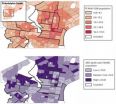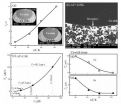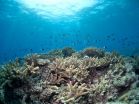(Press-News.org) PROVIDENCE, R.I. [Brown University] — In U.S. cities, it's not just what you do, but also your address that can determine whether you will get HIV and whether you will survive. A new paper in the American Journal of Public Health illustrates the effects of that geographic disparity – which tracks closely with race and poverty – and calls for an increase in geographically targeted prevention and treatment efforts.
"People of color are disproportionately impacted, and their risk of infection is a function not just of behavior but of where they live and the testing and treatment resources in their communities," said lead author Amy Nunn, assistant professor (research) of behavioral and social sciences in the Brown University School of Public Health. "Limited health services mean more people who don't know their HIV status and who are not on treatment. People who don't have access to treatment are much more likely to infect others. Simply having more people in your sexual network with uncontrolled HIV infection raises the probability that you will come into contact with the virus. This is not just about behavior, this is about access to critical health services."
It's no secret that the United States has economic disparities in access to health care, but the consequences of that for the HIV epidemic are laid bare in maps in the paper. They show that the nation's epidemic has become concentrated in urban minority neighborhoods, where HIV incidence can be comparable to some countries of sub-Saharan Africa.
The high-incidence minority neighborhoods of New York and Philadelphia, the maps show, have a high death rate as well, even compared to simlarly high-incidence neighborhoods that are wealthier and whiter. The most likely difference between the communities, Nunn said, is in their access to testing, treatment, and care services.
Nunn and co-authors including Phill Wilson, president and CEO of the Black AIDS Institute, said federal and state public health efforts should recognize that geography contributes to HIV risk and focus greater efforts on targeting the most heavily impacted neighborhoods around the country. Instead, there has been less federal money for interventions outside of clinical settings.
"With the new surveillance tools available to us, we know where the epidemic is down to the census track or zip code," Wilson said. "If we are serious about ending the AIDS epidemic in this country, we need to use those tools to invest in vulnerable communities. Unfortunately, instead of building infrastructure and expanding capacity in poor urban communities, we are dismantling the fragile infrastructure that exists."
Early efforts
Aware of the need, many of the paper's authors have helped put together neighborhood testing and treatment campaigns in recent years. The projects provide templates, they say, for engaging local communities through grassroots action and partnership with local institutions and media. These not only spread the word, but also reduce the stigma of openly confronting the disease. The authors also argue for a research and policy agenda that focuses on neighborhoods rather than solely on individuals for HIV intervention strategies.
An especially large effort, "The Bronx Knows," led by the New York City Department of Health, brought together 75 local institutions and other partners between 2008 and 2011 to cover the entire New York City borough. The campaign, in part led by co-author Dr. Blayne Cutler, conducted more than 600,000 tests and confirmed 4,800 cases, including 1,700 that weren't previously known. The percentage of local adults who reported having been tested rose to 80 percent from 72 percent and HIV positive residents linked to appropriate health care rose to 84 percent from 82 percent.
Since 2012 Nunn has led a privately funded project focused on Philadelphia's 19143 zip code, one of the most heavily impacted neighborhoods of the country, called "Do One Thing." Working with colleagues including co-author Dr. Stacey Trooskin of Drexel University, Do One Thing has partnered with local media and leaders including clergy, and sent volunteers door-to-door to promote HIV and HCV testing and treatment.
So far Nunn's teams have tested more than 6,000 residents with an HIV rate of 0.7 percent. They simultaneously test for hepatitis C and have found that 5 percent of those who test are HCV positive. When people test positive for either virus, the teams immediately link them to health services and treatment.
Targeting testing and treatment
Other efforts of varying nature and scale are underway in San Diego, Oakland, Washington D.C., and Miami, but in the article the authors report that such campaigns are not yet enough to turn every tide that has flooded neighborhoods around the country with especially high degrees of infection and mortality.
More of the money granted to states and cities, for instance, could be targeted to the neighborhoods with highest infection rates and where testing and treatment have been most lacking.
"Many of our resources don't go to the communities who need them most," Nunn said. "But we know exactly where people live who are becoming infected. We have so many tools that we know are effective at fighting the epidemic. Not to provide them to the most heavily impacted communities is a social injustice. We should be rolling out testing and treatment services and positive social marketing messages en masse in these communities."
INFORMATION:
In addition to Nunn, Wilson, Cutler and Trooskin, the paper's other authors are Annajane Yolken of The Miriam Hospital, Dr. Susan Little of the University of California–San Diego, and Dr. Kenneth Mayer of Brown University, Harvard University, and the Fenway Community Health Center in Boston.
The National Institutes of Health, including the Lifespan Tufts Brown Center for AIDS Research, the Gilead Sciences HIV focus program, and the California HIV Research Program, provided support for the paper.
HIV battle must focus on hard-hit streets, paper argues
2014-04-10
ELSE PRESS RELEASES FROM THIS DATE:
Obsessive-compulsive disorder may reflect a propensity for bad habits
2014-04-10
Philadelphia, PA, April 10, 2014 – Two new studies published this week in Biological Psychiatry shed light on the propensity for habit formation in obsessive-compulsive disorder (OCD). These studies suggest that a tendency to develop habits, i.e., the compulsive component of the disorder, may be a core feature of the disorder rather than a consequence of irrational beliefs. In other words, instead of washing one's hands because of the belief that they are contaminated, some people may develop concerns about hand contamination as a consequence of a recurring urge to wash ...
Solute redistribution profiles during rapid solidification of undercooled ternary Co-Cu-Pb alloy
2014-04-10
Researchers at the Department of Applied Physics, Northwestern Polytechnical University, in Xi'an, China, are engaged in revealing the mysteries of solidification process and the development of new materials using self-designed experimental instrument which can simulate the space environment such as containerless state. Solidification mechanism is of great importance to better understand the relationship between solidification process and microstructure evolution, so that we can follow them to design and prepare new materials which can meet the application requirements.
Dr. ...
New report provides solution to NEET challenge in UK and abroad
2014-04-10
A NEW strategy to help young people find jobs that pay fair wages, accompanied by high quality training and better career opportunities, has been developed by a University of Huddersfield professor. Outlined in a specially-commissioned research report, it is beginning to catch the attention of policy-makers throughout the UK.
After conducting years of funded research into the challenges that face young people dubbed NEET – meaning that they are not in employment, education or training – Professor Robin Simmons has devised the concept of a Youth Resolution designed to ...
Researchers show fruit flies have latent bioluminescence
2014-04-10
WORCESTER, Mass. – New research from scientists at the University of Massachusetts Medical School shows that fruit flies are secretly harboring the biochemistry needed to glow in the dark —otherwise known as bioluminescence.
The key to activating this latent ability is a novel synthetic analog of D-luciferin developed at UMMS. The findings, published in the journal Proceedings of the National Academy of Sciences, suggest that the inherent biochemistry needed for bioluminescence is more common than previously thought. Synthetic luciferins can unmask latent enzymatic ...
Coral reefs of the Mozambique Channel a leading candidate for saving marine diversity
2014-04-10
Marine scientists keen on finding patterns of coral decline and persistence in gradually warming oceans have a complex challenge: how to save reefs containing the most diversity with limited resources. In the Western Indian Ocean, researchers from the Wildlife Conservation Society, the University of Warwick, the ARC Centre for Excellence of Coral Reef Studies, Simon Fraser University, University of North Carolina at Chapel Hill, and other groups have found that the corals of the Mozambique Channel should be a priority for protection as climate change continues to threaten ...
Reef fish arrived in 2 waves
2014-04-10
The world's reefs are hotbeds of biological diversity, including over 4,500 species of fish. A new study shows that the ancestors of these fish colonized reefs in two distinct waves, before and after the mass extinction event about 66 million years ago that wiped out the dinosaurs.
Reef fish represent one of the largest and most diverse assemblages of vertebrates, according to Samantha Price, a postdoctoral researcher in the Department of Evolution and Ecology at UC Davis. Price is first author on a paper describing the work, published April 2 in the journal Proceedings ...
CU researchers unraveling what's behind the sniffles, hoping for a treatment
2014-04-10
Scientists at the University of Colorado School of Medicine have shed light on one of the most common of ailments – the runny nose.
Your respiratory tract is under constant attack and the nose is the first line of defense. Often, especially as the weather warms, the assault comes from allergens, which cause the body to fight off a perceived threat. Infections, too, are a problem.
But millions of people get a runny nose and have difficulty breathing without an allergic attack or infection. What many people call the sniffles, scientists refer to as "non-allergic rhinitis."
Although ...
China looks to science and technology to fuel its economy
2014-04-10
Maintaining stability in the face of rapid change and growth, and proactively partaking in cooperative global ties in science and technology fields will be key in helping China become an innovation-based economy, according to Denis Simon, vice provost for International Strategic Initiatives at Arizona State University.
One of the world's leading experts on science, technology and innovation in China, Simon recently hosted an ASU conference that focused on the evolving role of science and technology in China's international relations.
Supplemented with strategic investments ...
Researchers looking to create new bone tissue generation technique
2014-04-10
UT Arlington and Texas Health Arlington Memorial Hospital are investigating whether bone grown from the body's own stem cells can replace traditional types of bone grafting.
The process, which has been successful in previous lab experiments, uses biodegradable polymer scaffolding material and bone morphogenetic protein, or BMP, which was inserted into the abdomen of mice to attract stem cells that in turn produced bone. BMPs are proteins known to promote bone growth. The research is detailed in a new paper, "Tissue Engineering Bone Using Autologous Progenitor Cells in ...
La Brea Tar Pit fossil research shows climate change drove evolution of Ice Age predators
2014-04-10
LOS ANGELES — Concerns about climate change and its impact on the world around us are growing daily. New scientific studies at the La Brea Tar Pits are probing the link between climate warming and the evolution of Ice Age predators, attempting to predict how animals will respond to climate change today.
The La Brea Tar Pits are famous for the amazing array of Ice Age fossils found there, such as ground sloths, mammoths, and predators like saber-toothed cats and powerful dire wolves. But the climate during the end of the Ice Age (50,000-11,000 years ago) was unstable, ...





